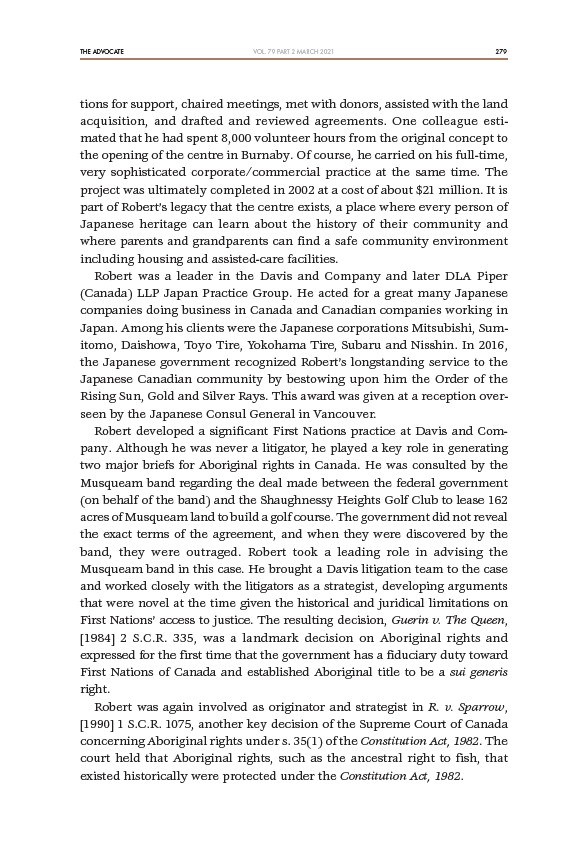
THE ADVOCATE 279
VOL. 79 PART 2 MARCH 2021
tions for support, chaired meetings, met with donors, assisted with the land
acquisition, and drafted and reviewed agreements. One colleague estimated
that he had spent 8,000 volunteer hours from the original concept to
the opening of the centre in Burnaby. Of course, he carried on his full-time,
very sophisticated corporate/commercial practice at the same time. The
project was ultimately completed in 2002 at a cost of about $21 million. It is
part of Robert’s legacy that the centre exists, a place where every person of
Japanese heritage can learn about the history of their community and
where parents and grandparents can find a safe community environment
including housing and assisted-care facilities.
Robert was a leader in the Davis and Company and later DLA Piper
(Canada) LLP Japan Practice Group. He acted for a great many Japanese
companies doing business in Canada and Canadian companies working in
Japan. Among his clients were the Japanese corporations Mitsubishi, Sumitomo,
Daishowa, Toyo Tire, Yokohama Tire, Subaru and Nisshin. In 2016,
the Japanese government recognized Robert’s longstanding service to the
Japanese Canadian community by bestowing upon him the Order of the
Rising Sun, Gold and Silver Rays. This award was given at a reception overseen
by the Japanese Consul General in Vancouver.
Robert developed a significant First Nations practice at Davis and Company.
Although he was never a litigator, he played a key role in generating
two major briefs for Aboriginal rights in Canada. He was consulted by the
Musqueam band regarding the deal made between the federal government
(on behalf of the band) and the Shaughnessy Heights Golf Club to lease 162
acres of Musqueam land to build a golf course. The government did not reveal
the exact terms of the agreement, and when they were discovered by the
band, they were outraged. Robert took a leading role in advising the
Musqueam band in this case. He brought a Davis litigation team to the case
and worked closely with the litigators as a strategist, developing arguments
that were novel at the time given the historical and juridical limitations on
First Nations’ access to justice. The resulting decision, Guerin v. The Queen,
1984 2 S.C.R. 335, was a landmark decision on Aboriginal rights and
expressed for the first time that the government has a fiduciary duty toward
First Nations of Canada and established Aboriginal title to be a sui generis
right.
Robert was again involved as originator and strategist in R. v. Sparrow,
1990 1 S.C.R. 1075, another key decision of the Supreme Court of Canada
concerning Aboriginal rights under s. 35(1) of the Constitution Act, 1982. The
court held that Aboriginal rights, such as the ancestral right to fish, that
existed historically were protected under the Constitution Act, 1982.